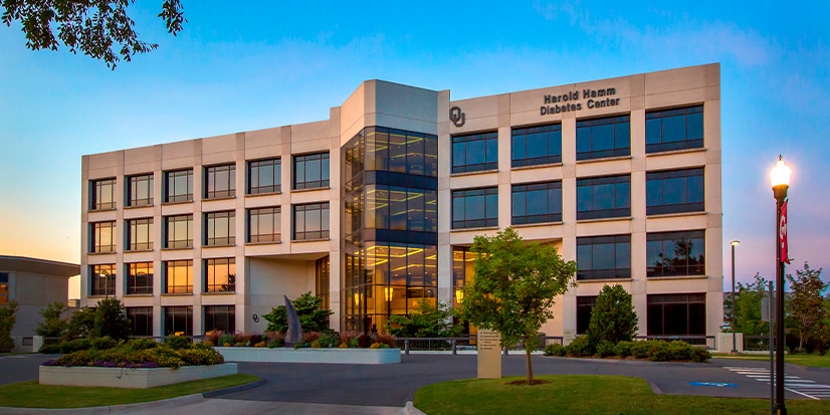Brain & Spine Tumors
Benign brain tumors (non-cancerous growths) originate in brain tissue but do not invade the brain. Many brain tumors are benign and don’t spread to other parts of the body, but any tumor can affect you in multiple ways.
A malignant (cancerous) brain tumor grows much faster than a benign one. Although brain tumors do not spread to other areas of the body, they can reach other parts of the brain and the central nervous system. That’s why you want to talk with the brain and spine tumor teams at OU Health Stephenson Cancer Center in Oklahoma City.
Comprehensive Brain & Spine Tumor Care Close to Home
When you work with the tumor specialists at Stephenson Cancer Center, Oklahoma’s only National Cancer Institute (NCI)-Designated Cancer Center, you become part of a multidisciplinary team using the most innovative, evidence-based approaches to diagnose, treat and manage your specific brain and spine tumor condition. You’ll work with the most highly trained specialists in the region who focus on these conditions.
Symptoms of Brain & Spine Tumors
A benign or malignant brain tumor may affect your health if you experience symptoms such as changes in vision or personality, seizures, difficulty walking or speaking, morning nausea and vomiting, as well as memory and balance problems. Spinal tumors may cause neck or back pain or weakness of the extremities or difficulties with daily functions.
Brain & Spine Cancers We Treat
Get the comprehensive care you need at Stephenson Cancer Center for all types of common and rare brain and spine tumors, including:
Benign Tumors
- Pituitary Adenoma
- Schwannoma
- Craniopharyngioma
- Neurofibromatosis type 2
- Skull base tumors
- Pituitary tumors
Malignant Tumors
- Glioblastoma (GBM)
- Medulloblastoma
- Meningioma
- Metastatic brain tumor
- Oligodendroglioma
- Ependymoma
- Astrocytoma
Other Types
- Hemangioblastoma
- Chordomas
Additional Types of Spine Tumors
- Osteosarcoma
- Neurofibroma
- Metastatic Tumors
Located at the base of the brain and arising from the pituitary gland, these tumors can disrupt hormone production. Various symptoms of pituitary tumors include blurred or double vision, dizziness, fatigue, headaches, loss of peripheral vision, sudden loss of vision, numbness or pain in the face, or fainting. Most pituitary tumors are benign and treatable through surgery or chemotherapy. For small tumors, a minimally invasive endoscopic approach is often used, which avoids external incisions. In more complex cases, traditional craniotomy may be necessary. Early detection and a tailored treatment plan are essential for optimal outcomes.
Brain & Spine Tumor Services & Treatments
At Stephenson Cancer Center, you’ll work with your doctor and other specialists to complete an extensive evaluation for an accurate diagnosis. You’ll also participate in developing a comprehensive care plan that fits your particular situation.
When detected early, brain and spine tumors respond well to specialized surgical removal. However, tumors located on sensitive, hard-to-reach areas require different options, such as radiation therapy or chemotherapy to shrink the tumor and destroy lingering cancer cells.
As you and your multidisciplinary team review your options, you also may take advantage of many innovative treatments, including:
- Endoscopic endonasal surgery
- Skull base tumor procedures
- Minimally invasive (keyhole) surgery to help improve recovery
- Functional mapping – Awake brain surgery
- Advanced techniques for spine surgery
- Gamma Knife® stereotactic radiosurgery – Noninvasive radiation therapy procedure to shrink tumors through repeated treatment
- Proton radiation therapy – Advanced treatment available in the region only at OU Health Stephenson Cancer Center
- Immunotherapy
- Individualized neurological and systemic symptom management
- Non-traditional therapies
Pituitary Tumors
Located at the base of the brain and arising from the pituitary gland, these tumors can disrupt hormone production. Various symptoms of pituitary tumors include blurred or double vision, dizziness, fatigue, headaches, loss of peripheral vision, sudden loss of vision, numbness or pain in the face, or fainting. Most pituitary tumors are benign and treatable through surgery or chemotherapy. For small tumors, a minimally invasive endoscopic approach is often used, which avoids external incisions. In more complex cases, traditional craniotomy may be necessary. Early detection and a tailored treatment plan are essential for optimal outcomes.
Cancer Navigation Services
Throughout your journey at Stephenson Cancer Center, your care team includes a nurse navigator, a specially trained registered nurse (RN) who acts as your personal advocate and adds an extra layer of support. Learn more about cancer navigation services.
Supportive Care Services
You also gain access to extensive supportive care services, such as genetic counseling, nutritional therapy, support groups, palliative care, cancer education workshops, and symptom and pain management. And you’ll find all your cancer-related services in a bright, welcoming, up-to-date facility close to home and designed for your comfort and convenience.
Clinical Trials for Advanced Treatment
In Stephenson Cancer Center’s comprehensive program, you also may qualify to participate in cancer clinical trials as part of the National Cancer Institute’s National Clinical Trials Network (NCTN), giving you early access to today’s newest drugs and potential breakthrough treatments before they become widely available.
Your Expert Brain & Spine Tumor Team
In the Brain and Spine Tumor program at Stephenson Cancer Center, you’ll work with an exceptional team dedicated to brain and spine tumor treatment that includes nationally recognized neurosurgeons, radiation oncologists and neuro-oncologists, as well as Oklahoma’s only board-certified neuro-oncologists, recognized by the United Council for Neurologic Subspecialties. You benefit from skilled neurosurgeons who train in the most advanced techniques for operating in the brain and spine.
From your first contact with Stephenson, you become a vital part of our multidisciplinary team approach that brings you together with cancer specialists, such as medical oncologists, cancer surgeons, pathologists, radiologists and others, to ensure you receive the best care for your particular condition.

[1].jpg)
[1].jpg)


-
 May 19 OU Health Stephenson Cancer Center at Norman Regional | Community Open House
May 19 OU Health Stephenson Cancer Center at Norman Regional | Community Open HouseJoin us for a Community Open House, Monday, May 19, from 5-7 p.m., to celebrate the opening of OU ...
View Event Details -
 May 28 Gynecologic Cancers Support Group - Hope in Oklahoma
May 28 Gynecologic Cancers Support Group - Hope in OklahomaJoin us for the Hope in Oklahoma — Gynecologic Cancers Support Group where we discuss treatment, the ...
View Event Details -
 May 30 Spanish-Speaking Cancer Support Group
May 30 Spanish-Speaking Cancer Support GroupLast Friday of the month, 5 - 6:30 p.m. Conference Room 5058, Stephenson Cancer Center Contact: Carmen ...
View Event Details -
 June 03 Cellular Therapy and Bone Marrow Transplant Gathering
June 03 Cellular Therapy and Bone Marrow Transplant GatheringJoin us for a cellular therapy and bone marrow transplant support group where we create a community ...
View Event Details -
 June 06 Shair Mobile Wig Salon (OKC)
June 06 Shair Mobile Wig Salon (OKC)The Shair mobile wig salon will be parked outside of OU Health Stephenson Cancer Center on the first ...
View Event Details -
 June 12 Brain Tumor Support Group View Event Details
June 12 Brain Tumor Support Group View Event Details -
 July 26 2025 Men's Health Awareness Summit
July 26 2025 Men's Health Awareness SummitOU Health Stephenson Cancer Center is hosting a free, family-friendly health summit with a focus on ...
View Event Details
-
Overcoming Glioblastoma: Matt’s Path to Recovery and Research
Matt has always loved animals and the outdoors. His fascination grew as he watched Animal Planet as a child — his favorite episodes featuring ...
Read More -
Finding Answers: Jeff’s Journey to a Meningioma Diagnosis and Recovery
After almost 22 years of marriage and four kids, Kris Speers noticed that her 40-year-old husband, Jeff, was subtly changing. After working as a ...
Read More






.png)





.png)
